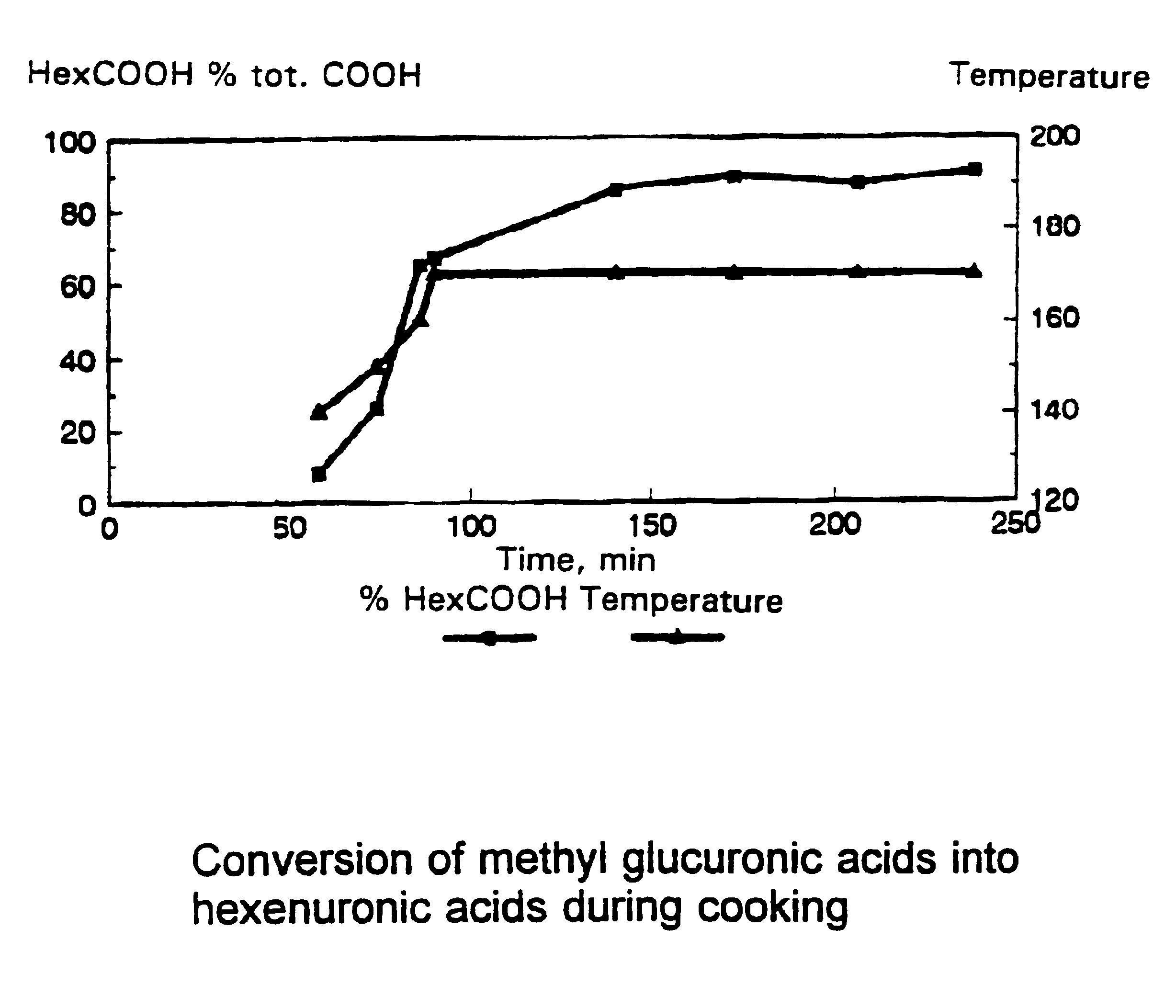Method of modifying a xylan-containing carbohydrate substrate having hexenuronic acid groups attached to the xylan
a technology of hexenuronic acid and carbohydrate, which is applied in the field of modifying a xylan-containing carbohydrate substrate, can solve the problems of poor substrate for enzymatic (hemicellulase) treatment and unoptimized action of xylanases, and achieve the effect of improving low-chlorine or chlorine-free bleaching methods and reducing environmental pollution
- Summary
- Abstract
- Description
- Claims
- Application Information
AI Technical Summary
Benefits of technology
Problems solved by technology
Method used
Image
Examples
example 1
Preparation of Oligosaccharides Containing Hexenuronic Acid (HexA)
Birch kraft pulp with kappa number of 17-18 was obtained from Kaukas pulp mill. First the composition of the pulp was analysed as follows to confirm that the content of hexenuronic acid in the pulp was adequate. The pulp was treated by xylanase (pI 9) of T. reesei at 40.degree. C. for 24 h, resulting in solubilization of 27% of pulp xylan. The consistency of the pulp in the hydrolysis was 5%, enzyme dosage was 10,000 nkat / g pulp and the pH was adjusted to pH 5.0 by sulphuric acid. After the hydrolysis the sample was filtrated, boiled and lyophilized. The lyophilizate was analysed by NMR. The sugar constituents of the hydrolysate were:
To release oligomeric HexA-containing oligomers 223 kg of the wet pulp was gradually added in 400 l of water during the first 24 hours of enzyme treatment and hydrolysed with commercial cellulase (Econase, Oy Alko Ab) and xylanase (Ecopulp, Oy Alko Ab) preparations. The enzyme dosages der...
example 2
Preparation of Xylan Containing Hexenuronic Acid (HexA)
Glucuronoxylan (Roth 7500, 7.5 g) was treated with sodium borohydride (100 mg) in alkaline conditions (150 ml of 1 M NaOH). Xylan was first solubilized and a clear solution obtained. The vessel was closed and air in the vessel was replaced by nitrogen. The solution was incubated at room temperature overnight. After this the closed vessel was incubated at 150.degree. C. for 2 h and cooled with cold water.
The solution was removed from the vessel and 7.5 ml of glycerol was added. The solution was neutralized by concentrated formic acid to pH 7. 150 ml of methanol was added dropwise with continuous stirring and the precipitate formed was removed by centrifugation. The precipitate formed was washed first with ethanol / water (1:1, 150 ml) and then with methanol (150 ml). The precipitate was dried at room temperature. The weight of the dry precipitate was 6.31 g (84% of the original xylan)
To analyse the xylan prepared, a small sample wa...
example 3
Detection of Hexenuronidase Activity.
Hexenuronidase activity was detected by thin layer chromatography using the following procedure:
20 .mu.l of enzyme sample was incubated with 20 .mu.l of the hexenuronidase substrate (purified hexenuronoxylobiose. HexAX.sub.2, prepared as described in Example 1, 0.2% solution in 50 mM Na-citrate, pH 5.3; or mixture of HexAX.sub.2 and HexAX.sub.3 obtained by a single gel filtration run) for 60 min at 50.degree. C. Approximately 2 .mu.l of the reaction mixture was applied as a small dot near (distance ca. 2 cm) the side of the chromatography plate (DC-Alufolien, Kieselgel 60, Merck Art, 5553). The plate was put sample side down in a glass chamber containing running solvent (50 vol-% acetone. 40% n-butanol and 10% distilled water, at a depth of 1.0-1.5 cm from the bottom). The running chamber was closed and the solvent front was allowed to rise approximately to the middle of the plate.
The xylobiose or xylotriose liberated in the hydrolysis reaction w...
PUM
| Property | Measurement | Unit |
|---|---|---|
| Kappa number | aaaaa | aaaaa |
| kappa number | aaaaa | aaaaa |
| pH | aaaaa | aaaaa |
Abstract
Description
Claims
Application Information
 Login to View More
Login to View More - R&D
- Intellectual Property
- Life Sciences
- Materials
- Tech Scout
- Unparalleled Data Quality
- Higher Quality Content
- 60% Fewer Hallucinations
Browse by: Latest US Patents, China's latest patents, Technical Efficacy Thesaurus, Application Domain, Technology Topic, Popular Technical Reports.
© 2025 PatSnap. All rights reserved.Legal|Privacy policy|Modern Slavery Act Transparency Statement|Sitemap|About US| Contact US: help@patsnap.com


